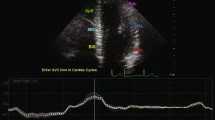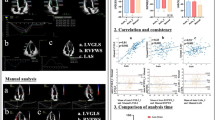Abstract
The association between left ventricular (LV) myocardial deformation and hemodynamic forces is still mostly unexplored. The normative values and the effects of demographic and technical factors on hemodynamic forces are not known. The authors studied the association between LV myocardial deformation and hemodynamic forces in a large cohort of healthy volunteers. One-hundred seventy-six consecutive subjects (age range, 16–82; 51% women), with no cardiovascular risk factors or any relevant diseases, were enrolled. All subjects underwent an echo-Doppler examination. Both 2D global myocardial and endocardial longitudinal strain (GLS), circumferential strain (GCS), and the hemodynamic forces were measured with new software that enabled to calculate all these values and parameters from the three apical views. Higher LV mass index and larger LV volumes were found in males compared to females (85 ± 17 vs 74 ± 15 g/m2 and 127 ± 28 vs 85 ± 18 ml, p < 0.0001 respectively) while no differences of the mean values of endocardial and myocardial GLS and of myocardial GCS were found (p = ns) and higher endocardial GCS in women (− 30.6 ± 4.2 vs − 31.8 ± 3.7; p = 0.05). LV longitudinal force, LV systolic longitudinal force and LV impulse were higher in men (16.2 ± 5.3 vs 13.2 ± 3.6; 25.1 ± 7.9 vs 19.4 ± 5.6 and 20.4 ± 7 vs 16.6 ± 5.2, p < 0.0001, respectively). A weak but statistically significant decline with age (p < 0.0001) was also found for these force parameters. This new integrated approach could differentiate normality from pathology by providing average deformation values and hemodynamic forces parameters, differentiated by age and gender.








Similar content being viewed by others
References
Solomon SD, Anavekar N, Skali H, McMurray J, Swedberg K, Yusuf S et al (2005) Influence of ejection fraction on cardiovascular outcomes in a broad spectrum of heart failure patients. Circulation 112(24):3738–3744
Tops LF, Delgado V, Marsan NA, Bax JJ (2017) Myocardial strain to detect subtle left ventricular systolic dysfunction. Eur J Heart Fail 19(3):307–313
Knuuti J, Wijns W, Saraste A, Capodanno D, Barbato E, Funck-Brentano C et al (2020) 2019 ESC Guidelines for the diagnosis and management of chronic coronary syndromes. Eur Heart J 41:407–477
Pedrizzetti G, Lapinskas T, Tonti G, Stoiber L, Zaliunas R, Gebker R et al (2019) The Relationship Between EF and Strain Permits a More Accurate Assessment of LV Systolic Function. J Am Coll Cardiol Img 12(9):1893–1895
Lapinskas T, Pedrizzetti G, Stoiber L, Düngen HD, Edelmann F, Pieske B et al (2019) The intraventricular hemodynamic forces estimated using routine CMR cine images: a new marker of the failing heart. J Am Coll Cardiol Imaging 12(2):377–379
Arvidsson PM, Töger J, Carlsson M, Steding-Ehrenborg K, Pedrizzetti G, Heiberg E et al (2017) Left and right ventricular hemodynamic forces in healthy volunteers and elite athletes assessed with 4D flow magnetic resonance imaging. Am J Physiol 312:H314–H328
Eriksson J, Bolger AF, Ebbers T, Carlhäll CJ (2016) Assessment of left ventricular hemodynamic forces in healthy subjects and patients with dilated cardiomyopathy using 4D flow MRI. Physiol Rep 4:741–747
Dal Ferro M, Stolfo D, De Paris V, Lesizza P, Korcova R, Collia D et al (2018) Cardiac fluid dynamics meets deformation imaging. Cardiovasc Ultrasound 16(1):1–10
Cosyns B, Garbi M, Separovic J, Pasquet A, Lancellotti P (2013) Update of the Echocardiography Core Syllabus of the European Association of Cardiovascular Imaging (EACVI). Eur Heart J Cardiovasc Imaging 14(9):837–839
Lang RM, Badano LP, Mor-Avi V, Afilalo J, Armstrong A, Ernande L et al (2015) Recommendations for cardiac chamber quantification by echocardiography in adults: an update from the American society of echocardiography and the European association of cardiovascular imaging. Eur Heart J Cardiovasc Imaging 16(3):233–271
Devereux RB, Alonso DR, Lutas EM, Gottlieb GJ, Campo E, Sachs IRN (1986) Echocardiographic assessment of left ventricular hypertrophy: comparison to necropsy findings. Am J Cardiol 57:450–458
Lang RM, Bierig M, Devereux RB, Flachskampf FF, Foster E, Pellikka PA et al (2005) Recommendations for chamber quantification: a report from the American Society of Echocardiography’s guidelines and standards committee and the Chamber Quantification Writing Group, developed in conjunction with the European Association of Echocardiograph. J Am Soc Echocardiogr 18(12):1440–1463
Nagueh SF, Smiseth OA, Appleton CP, Byrd BF, Dokainish H, Edvardsen T et al (2016) Recommendations for the evaluation of left ventricular diastolic function by echocardiography: an update from the American Society of Echocardiography and the European Association of Cardiovascular Imaging. Eur Heart J Cardiovasc Imaging 17(12):1321–1360 Epub 2016 Jul 15
Voigt JU, Pedrizzetti G, Lysyansky P, Marwick TH, Houle H, Baumann R et al (2015) Definitions for a common standard for 2D speckle tracking echocardiography: consensus document of the EACVI/ASE/Industry Task Force to standardize deformation imaging. Eur Heart J Cardiovasc Imaging 16(1):1–11
Saito K, Okura H, Watanabe N, Hayashida A, Obase K, Imai K et al (2009) Comprehensive evaluation of left ventricular strain using speckle tracking echocardiography in normal adults: comparison of three-dimensional and two-dimensional approaches. J Am Soc Echocardiogr 22(9):1025–1030
Stokke TM, Hasselberg NE, Smedsrud MK, Sarvari SI, Haugaa KH, Smiseth OA et al (2017) Geometry as a confounder when assessing ventricular systolic function: comparison between ejection fraction and strain. J Am Coll Cardiol 70(8):942–954
Pedrizzetti G, Tanacli R, Lapinskas T, Zovatto L, Pieske B, Tonti G et al (2019) Integration between volumetric change and strain for describing the global mechanical function of the left ventricle. Med Eng Phys 74:65–72
Pedrizzetti G, Arvidsson PM, Töger J, Borgquist R, Domenichini F, Arheden H et al (2017) On estimating intraventricular hemodynamic forces from endocardial dynamics: a comparative study with 4D flow MRI. J Biomech 60:203–210
Pedrizzetti G (2019) On the computation of hemodynamic forces in the heart chambers. J Biomech 95:109323
Muraru D, Cucchini U, Mihǎilǎ S, Miglioranza MH, Aruta P, Cavalli G et al (2014) Left ventricular myocardial strain by three-dimensional speckle-tracking echocardiography in healthy subjects: reference values and analysis of their physiologic and technical determinants. J Am Soc Echocardiogr 27(8):858–872
Altiok E, Neizel M, Tiemann S, Krass V, Kuhr K, Becker M et al (2012) Quantitative analysis of endocardial and epicardial left ventricular myocardial deformation—comparison of strain-encoded cardiac magnetic resonance imaging with two-dimensional speckle-tracking echocardiography. J Am Soc Echocardiogr 25(11):1179–1188
Path G, Robitaille PM, Merkle H, Tristani M, Zhang J, Garwood M et al (1990) Correlation between transmural high energy phosphate levels and myocardial blood flow in the presence of graded coronary stenosis. Circ Res 67(3):660–673
Alcidi GM, Esposito R, Evola V, Santoro C, Lembo M, Sorrentino R et al (2018) Normal reference values of multilayer longitudinal strain according to age decades in a healthy population: a single-centre experience. Eur Heart J Cardiovasc Imaging 19(12):1390–1396
Marwick TH, Leano RL, Brown J, Sun JP, Hoffmann R, Lysyansky P et al (2009) Myocardial strain measurement with 2-dimensional speckle-tracking echocardiography. Definition of normal range. J Am Coll Cardiol Imaging 2(1):80–84
Sugimoto T, Dulgheru R, Bernard A, Ilardi F, Contu L, Addetia K et al (2017) Echocardiographic reference ranges for normal left ventricular 2D strain: results from the EACVI NORRE study. Eur Heart J Cardiovasc Imaging 18(8):833–840
Coiro S, Huttin O, Bozec E, Selton-Suty C, Lamiral Z, Carluccio E et al (2017) Reproducibility of echocardiographic assessment of 2D-derived longitudinal strain parameters in a population-based study (The STANISLAS Cohort Study). Int J Cardiovasc Imaging 33(9):1361–1369
Cheng S, Fernandes VRS, Bluemke DA, McClelland RL, Kronmal RA, Lima JAC (2009) Age-related left ventricular remodeling and associated risk for cardiovascular outcomes the multi-ethnic study of atherosclerosis. Circ Cardiovasc Imaging 2(3):191–198
Potter E, Marwick TH (2018) Assessment of left ventricular function by echocardiography: the case for routinely adding global longitudinal strain to ejection fraction. J Am Coll Cardiol Img. 11(2P1):260–274
Tanaka H (2019) Utility of strain imaging in conjunction with heart failure stage classification for heart failure patient management. J Echocardiogr 17(1):17–24
Arvidsson PM, Töger J, Carlsson M, Steding-Ehrenborg K, Pedrizzetti G, Heiberg E et al (2017) Left and right ventricular hemodynamic forces in healthy volunteers and elite athletes assessed with 4D flow magnetic resonance imaging. Am J Physiol Heart Circ Physiol 312(2):H314–H328
Funding
DC and GP received partial support for this study from the Italian Ministry of Education and Research, project PRIN No. 2017A889FP.
Author information
Authors and Affiliations
Contributions
GF and GP conceived and designed research; GF, GP and DC interpreted results of experiments; DC prepared figures; DC, and GP analyzed data; SF, LP, MZ, performed experiments; GF, and GP drafted manuscript; ADL edited and revised manuscript; GF, DC, SF, LP, MZ, GP, and ADL approved final version of manuscript.
Corresponding author
Ethics declarations
Conflict of interest
GP is s senior scientific consultant for Medis Medical Imaging Systems BV (Leiden, The Netherlands). GF, DC, SF, LP, MZ and ADL have no conflict of interest to declare.
Additional information
Publisher's Note
Springer Nature remains neutral with regard to jurisdictional claims in published maps and institutional affiliations.
Rights and permissions
About this article
Cite this article
Faganello, G., Collia, D., Furlotti, S. et al. A new integrated approach to cardiac mechanics: reference values for normal left ventricle. Int J Cardiovasc Imaging 36, 2173–2185 (2020). https://doi.org/10.1007/s10554-020-01934-1
Received:
Accepted:
Published:
Issue Date:
DOI: https://doi.org/10.1007/s10554-020-01934-1




